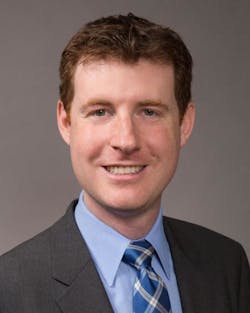Healthcare IT leaders are moving forward in a number of directions at UCLA Health, the four-hospital, 2,000-physician integrated health system in Los Angeles. As the organization advances in its work on data-sharing, on the leveraging of data analytics to support accountable care and population health work, and on patient/healthcare consumer engagement, the healthcare IT team at UCLA Health is moving forward under the leadership of Michael Pfeffer, M.D., the organization’s vice chancellor and CIO. Dr. Pfeffer, who has been in his current position—which oversees the IT support both of the patient care organization and of the research organization, in the integrated health system—for three years, continues to practice part-time as a hospitalist.
Dr. Pfeffer recently spoke with Healthcare Informatics Editor-in-Chief Mark Hagland, and shared his perspectives on the various initiatives he’s helping to lead, as well as on his work as a CIO who continues to practice as a physician. Below are excerpts from their interview.
What has been the overall thrust of your work in the past three years?
Most CIOs will say that they’re involved in many, many different projects to support the operation—EHR [electronic health record] infrastructure upgrade, cybersecurity, clinician workflow redesign, and other areas. I’m also responsible for the school of medicine, so I’m looking at areas that support research as well.
What would you say have been the biggest breakthroughs in the last year, in your area?
I’d say we’ve been doing a lot of really good work on the patient-facing side, including the patient portal for our ambulatory and inpatient sides; we’ve done a lot of work with the use of cloud in terms of analytics, to allow our business analysts to create really nice visualizations in terms of data sets, and also around data governance. We’re about to do a major upgrade on our EHR platform. Also, a year now, we redid our entire laboratory system, bringing it over to the Epic Beaker system. And we’re an Epic shop overall.
Looking at the managed care/healthcare market in the L.A. Basin/Southern California, how would you paint a brief portrait of that market?
Well, I think the L.A. market is fairly unique in that there are a lot of players in the market, and a lot of insurers in the market, both, and that’s unusual. So we’re lucky in that there isn’t a single dominant insurer. That makes it exciting and challenging at the same time. In addition to all the changes going on at the policy and payment level in the federal government, that makes it quite a challenge to predict what’s going to happen. But all in all, all of the healthcare providers and insurers in the market are looking to take the best care of our patients no matter where they end up. So making sure we can exchange information among providers in real time, will be extremely important. And there’s anecdotal data showing that when you have records available, you don’t repeat as many tests or order as many procedures, when you have that information. So that’s what it’s all about, really.
That to me sounds like health information exchange or health data exchange, in the broadest sense. And how is that area working out for your organization?
Yes, that’s correct; and there actually have been some very exciting things going on in our market, in that area. Most of our exchanges occur with fellow Epic providers, and we use Care Everywhere [the Care Everywhere Network sponsored by the Verona, Wis.-based Epic Systems Corporation] for that. Epic-to-non-Epic is more of a challenge, but we’re making headway. We’ve signed up for Carequality, and we’re beginning to exchange records seamlessly between our site and other sites that don’t have Epic. And we’re also waiting for the CommonWell platform, which is basically Cerner’s version of CareEverywhere, and that would really connect the people in the L.A. Basin, no matter where they are.
How many sites or organizations are involved in all of those data and information exchanges?
In terms of Epic-to-Epic, we’ve exchanged patient records with organizations in all 50 states. In calendar year 2016, we did about 3.75 million record exchanges, Epic-to-Epic. In terms of Epic-to-non-Epic exchanges through Carequality, we’ve exchanged about 2,500 records with 21 organizations so far. That’s been after about six months so far.
And through CommonWell?
Care Everywhere is part of Carequality, and CommonWell is going to join Carequality—whose membership already includes Epic, eClinicalWorks, NextGen, athenahealth, etc.—CommonWell is going to join that large collaborative And Epic has been a really progressive player in the market. And being part of Carequality is very important, and exciting, and eliminates the need for health information exchanges, which have been struggling.
Are you participating in any accountable care organizations (ACOs) yet?
Yes, we’re in the MSSP [Medicare Shared Savings Program] with CMS [the federal Centers for Medicare and Medicaid Services].
Can you share your thoughts and perspectives on aligning data and leveraging analytics, for your ACO development work?
I think a lot of this is going to start to align with MACRA [the Medicare Access and CHIP Reauthorization Act of 2015, which has mandated physician participation in quality outcomes measurement and value-based purchasing] and the different advanced care management tracks within MACRA. Participating in MSSP qualifies you for different tracks for MACRA, including with ACI, advancing care information, which is the old meaningful use [and is now an element in the requirements under the MIPS program—the Merit-based Incentive Payment System—within the MACRA law]. We’re seeing that align. So I think things will hopefully get easier in that space, in terms of a more standardized way of reporting quality and value emerging. It’s been challenging, certainly, to align all of that for different payers and different programs. Hopefully, we’ll start to see more alignment.
What we’re hearing from all of the healthcare IT leaders we speak to is that a lot of work needs to be done to customize analytics solutions; that there are no “off-the-shelf” solutions that can simply be plugged in. And creating the interoperability or interfacing with the EHRs remains a challenge. What are your thoughts on that?
Yes, I absolutely agree. The data sets are incredibly complex. You really need to acquire the data scientists to help you find the data and figure out where it has to go. Here’s one typical example of the complexity involved: there is actually no value that you can pull out of the EHR that represents length of stay; instead, you have to create that value as a calculation, based on different time stamps. And determining how to calculate that correctly is something that requires data scientists. So it’s more than simply asking what your length of stay f or heart failure is. You have to determine what heart failure is. And then you have to determine what you consider length of stay, before you can even put that into a tool for population health work.
So it’s a lot more challenging than simply bolting something on. We’ve never had success simply trying to plug things in. But we are making a lot of headway. So if you have a very good data governance process, you can define what length of stay is for conditions, and you can code that to pull out the correct variable from the EHR. And then people can use that for different kinds of platforms. And as we build up our data governance and data model, it’s going to become a lot easier to build platforms to manage risk and manage populations, so that’s really where we’re focused. We want to move towards a self-service analytics model that has a robust data governance behind it, so that when we develop programs, we can feel comfortable that we’re using embedded data variables that are accurate.
Let’s talk a bit about your perspectives as a physician CIO. Do you still have time to practice clinically?
I do. In fact, I’m on service this week; I’m a hospitalist with an internal medicine background. I do about five or six weeks a year on hospital service. And I have a phenomenal team for backup, during the times I’m on service as a hospitalist.
What do you think physicians bring to the role, what do you bring?
That’s a great question. I’ve thought a lot about this. I have a lot of colleagues, obviously, who aren’t MDs. And I think basically, when you look at the leadership of the IT organization around the CIO, you basically find the people who are experts in the areas that you’re not, and bring them on board, right? And when I look across my team, I come with a clinical background, but I don’t come with the level of technological background that others have. So I need to make sure I have a really strong team with that background—which I do—to counter that gap. So what I’m saying is that it’s more about the team than the CIO. The CIO has to take into account the strategies the organization’s working with, and the team’s knowledge. And they have to be humble and ask a lot of questions and be willing to learn—and that may not necessarily be the strongest strength of MDs [chuckles]. But I get to use what my team develops, and that helps me also to relate to one of our customer bases, which is clinicians. I think that a CIO who is not an MD who has really strong clinical leadership under them, will have that covered as well. So I think it’s important to understand what you have in terms of strengths.
And you have a CMIO reporting to you?
Yes, I have a CMIO and CNIO both reporting to me.
How does that work? Is it better, being a physician CIO, with a CMIO reporting to you? Does it help both positions?
It’s phenomenal, actually, both [individuals] are. And we do different jobs; when I was the CMIO, I was really focusing on synching systems and working through clinician workflow and providing real-time alerts and clinical decision support. I don’t do that job anymore; I’m much more focused on the broad running of the organization. So I support my CMIO and CNIO in their efforts; it’s all working out very well.
And you speak the same language, as fellow clinicians, of course—that must be helpful.
Yes, I agree, that’s very helpful.
What are a few of the big things coming up in the next few years for you and your team?
A lot is around analytics and precision medicine; about how to use artificial intelligence, and about how to use NLP [natural language processing] to extract key information from unstructured data, and to support research. And on the technology side of the envelope, continuing to push the envelope in terms of providing excellent products for our clinicians to use. And on the patient-facing side of the world, we’ll be focusing on providing excellent portals and providing information for patients online, and providing patient-facing apps.
We want to keep engaging our patients. We have a patient-focused technology council, so we get to show them the technologies that we’re working on, and ask for their advice and feedback. We have about 10 patient representatives on that. They meet quarterly and it’s been in existence since April 2015.
All CIOs are facing a tsunami of things that have to be done, these days. Are you optimistic, going forward, when you look at all that needs to be done at UCLA Health?
Yes, I am. I think that this is an incredibly exciting time, actually; there’s no better time to be a CIO. We have incredible challenges, but the information needs have never been more important. So we definitely have a seat at the table now. And patients have never been considered a customer of IT, but more than ever, patients are interacting with our information. So we’ve really had to shift our thinking to be more patient-focused, population-focused, analytics-focused. It’s incredibly exciting; every day, I come to work and there are five or six new challenges to work on.



